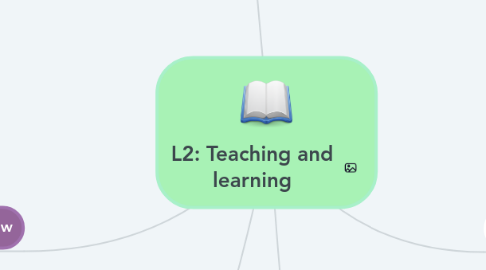
1. How
1.1. Innate capacity
1.1.1. A creative force involved in language development which must be an innate endowment.
1.2. Application of prior knowledge
1.2.1. An application of what has been acquired is part of general cognitive development, as well as of all prior social experience.
1.3. Processing of language input
1.3.1. Processing of input in itself is a necessary factor in acquisition.
1.4. Interaction
1.4.1. Processing of L2 input in interactional situations is facilitative, and some think also causative.
1.4.1.1. Collaborative expression, modified input, feedback (including correction), and negotiation of meaning.
1.5. Restructuring of the L2 knowledge system .
1.5.1. A creative process, driven by inner forces in interaction with environmental factors, and motivated both by L1 knowledge and by input from the L2
1.6. Associations between linguistic functions and forms.
1.6.1. This development is driven by communicative need and use.
1.7. Automatization
1.7.1. Frequency and practice lead to automaticity in processing, and they free learners’ processing capacity for new information and higher-order performance needs.
2. Implications for L2 learning and teaching
2.1. Considerating goals
2.2. Setting priorities
2.3. Multidimensional approach
2.4. Understanding learners
2.5. Careful approach to methods
2.6. Recognition and patience
3. What
3.1. System of knowledge about a L2 and patterns of recurring elements
3.1.1. Overlap with L1 with the L2. (vocab, morphology, phonology, syntax and discourse)
3.2. How to encode particular concepts in the L2
3.2.1. Grammatical notions of time, number of referents and the semantic role of elements.
3.3. Pragmatic competence
3.3.1. How to interpret and convey meaning in context of social interaction.
3.4. Means for using the L2
3.4.1. Listening, speaking, reading, writing.
3.5. How to select among multiple lang. systems
3.5.1. How to process multiple languages and how to switch between them.
3.6. Communicative competence: all of the above
3.6.1. Social and cultural knowledge required for appropriate use and interpretation of L2 forms.
4. Why
4.1. Social context
4.1.1. Is the L2 useful in the context it's being learned? How?
4.2. Social experience
4.2.1. Is the input valuable?
4.3. Relationships of L1 and L2
4.3.1. How does the L1 relate to the L2?
4.4. Age
4.4.1. What advantages does my age group have?
4.5. Aptitude
4.5.1. What is the learner "good" at?
4.6. Motivation
4.6.1. Is the learner willing to "make to the effort"?
4.7. Instruction
4.7.1. What is the methodological approach?

